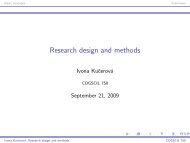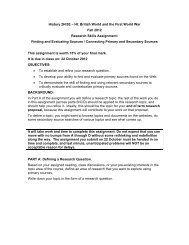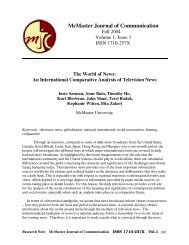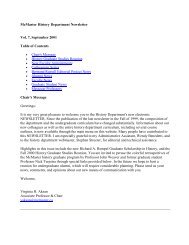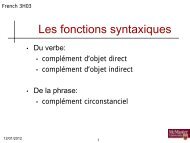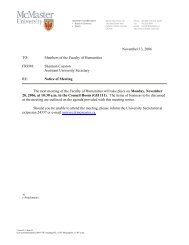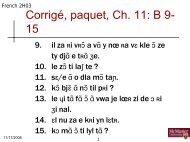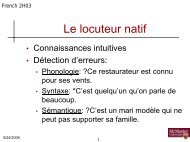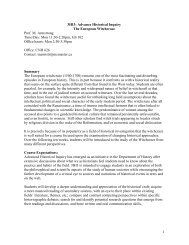The Syntax of Givenness Ivona Kucerová
The Syntax of Givenness Ivona Kucerová
The Syntax of Givenness Ivona Kucerová
You also want an ePaper? Increase the reach of your titles
YUMPU automatically turns print PDFs into web optimized ePapers that Google loves.
In the same way that there can be two separate G-operators, there can be two domains<br />
<strong>of</strong> G-movement. Thus, for example, there is no problem with having separate G-operators<br />
and separate G-movement in a matrix and in an embedded clause, as can be seen in (63).<br />
In this sentence, the given elements Petr and Marie are objects in two different clauses and<br />
they G-move within their clause, resulting in two independent partitions between given and<br />
new.<br />
(63) a. Do you know anything about Petr and Marie?<br />
b. Náhodou jsem slyšel, že Petrovi<br />
accidentally Aux.1sg heard that Petr.Dat<br />
Marii || zaměstnali v ABB.<br />
Marie.Acc employed.1pl in ABB<br />
|| říkala<br />
told<br />
nějaká<br />
some<br />
paní,<br />
lady<br />
že<br />
that<br />
‘I accidentally heard that some lady told Petr that Marie got employed in the<br />
ABB.’<br />
Similarly, in infinitival structures, some <strong>of</strong> the structurally higher elements can be given as<br />
well, or they can undergo G-movement, as in (64).<br />
(64) a. Do you know what Mary did with her famous boat?<br />
b. Marie || se pokusila lod’ || prodat.<br />
Marie REFL tried boat to-sell<br />
‘Marie tried to sell the boat (but no one wanted to buy it).’<br />
c. Marii || nařídil soud lod’ || prodat.<br />
Marie.Dat ordered court.Nom boat.Acc sell<br />
‘(You won’t believe it but) a court ordered Marie to sell the boat.’<br />
We can iterate the insertion <strong>of</strong> the G-operator even further, as in (65). In this case, one<br />
operator must be adjoined within the DP coordination (only one conjunct is given, not the<br />
whole coordination) and another operator is adjoined within the VP (below boat).<br />
(65) a. Do you know what Mary is planning to do with her broken boat?<br />
b. Marie || a nějaký automechanik budou lod’ || v létě opravovat.<br />
Marie and some car mechanic will boat in summer repair<br />
‘Marie and some car mechanic will repair the boat in the summer.’<br />
To summarize, we now have an informal way to characterize cases in which G-movement<br />
is licensed and we have a semantic operator which allows us to mark more than one G-<br />
element as presupposed. In the next section, I will develop a formal system which allows<br />
us to compare structures with respect to Maximize presupposition in a more precise way.<br />
Before we get to the next section notice that we have derived the size <strong>of</strong> a domain <strong>of</strong><br />
G-movement independently <strong>of</strong> head movement. <strong>The</strong> question is whether we still need the<br />
restriction on head movement or not. Also, it is not clear whether we can independently<br />
derive the fact that G-movement is very local.<br />
It looks like the head movement restriction only doubles the locality restriction imposed<br />
by the G-operator. Is this really true? Recall that the domain <strong>of</strong> G-movement varies in the<br />
107





